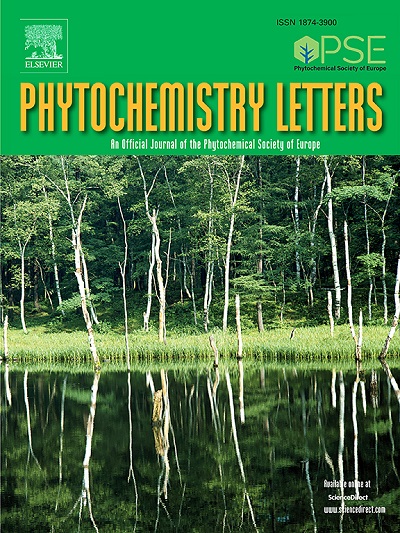降香黄檀中酚类化合物及其保肝活性
IF 1.4
4区 生物学
Q4 CHEMISTRY, MEDICINAL
引用次数: 0
摘要
从降香黄檀心材中分离得到21个酚类化合物,包括两个新的二苯基丙烯,r -7-甲氧基多酚素(1)和(Z)-1-(3-羟基苯基)-1-(2,4,5-三甲氧基苯基)-1-丙烯-3-醇(2)。通过综合光谱分析和量子化学计算确定了化合物1和2的结构。二面角松弛扫描,结合减少密度梯度(RDG)方法分析非共价相互作用,提供了化合物1的主要构象的见解,而理论ECD计算证实了它的绝对构型。采用d - galn诱导的AML12肝细胞损伤模型,对化合物1、5、7、12、13和20的肝保护活性进行了评估。值得注意的是,化合物1在30 μM时表现出显著的肝保护作用,与相同浓度的水飞蓟宾相当。本文章由计算机程序翻译,如有差异,请以英文原文为准。
Phenolic compounds from Dalbergia odorifera and their hepatoprotective activity
Twenty-one phenolic compounds, including two new diphenylpropenoids, R-7-methoxyodoriferin (1) and (Z)-1-(3-hydroxyphenyl)-1-(2,4,5-trimethoxyphenyl)-1-propen-3-ol (2), were isolated from the heartwood of Dalbergia odorifera. The structures of compounds 1 and 2 were determined through comprehensive spectroscopic analysis and quantum chemical calculations. A relaxed scan of the dihedral angle, combined with the reduced density gradient (RDG) method for analyzing noncovalent interactions, provided insights into the predominant conformation of compound 1, while theoretical ECD calculation confirmed its absolute configuration. The hepatoprotective activities of compounds 1, 5, 7, 12, 13, and 20 were evaluated using a D-GalN-induced AML12 hepatocyte injury model. Notably, compound 1 exhibited a significant hepatoprotective effect at 30 μM, comparable to that of silybin at the same concentration.
求助全文
通过发布文献求助,成功后即可免费获取论文全文。
去求助
来源期刊

Phytochemistry Letters
生物-生化与分子生物学
CiteScore
3.00
自引率
11.80%
发文量
190
审稿时长
34 days
期刊介绍:
Phytochemistry Letters invites rapid communications on all aspects of natural product research including:
• Structural elucidation of natural products
• Analytical evaluation of herbal medicines
• Clinical efficacy, safety and pharmacovigilance of herbal medicines
• Natural product biosynthesis
• Natural product synthesis and chemical modification
• Natural product metabolism
• Chemical ecology
• Biotechnology
• Bioassay-guided isolation
• Pharmacognosy
• Pharmacology of natural products
• Metabolomics
• Ethnobotany and traditional usage
• Genetics of natural products
Manuscripts that detail the isolation of just one new compound are not substantial enough to be sent out of review and are out of scope. Furthermore, where pharmacology has been performed on one new compound to increase the amount of novel data, the pharmacology must be substantial and/or related to the medicinal use of the producing organism.
 求助内容:
求助内容: 应助结果提醒方式:
应助结果提醒方式:


